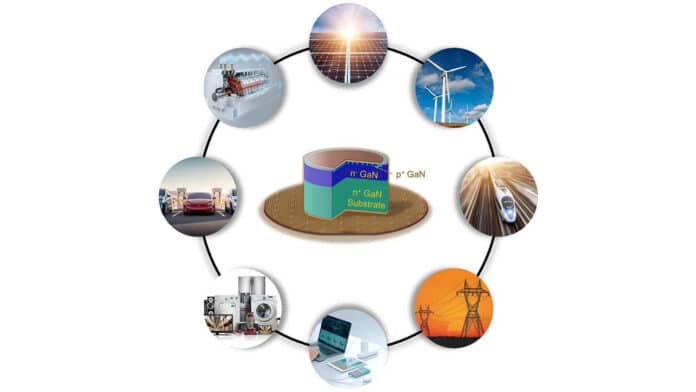Developing more efficient power electronics like power switches reduces the amount of power lost during the conversion process. This is particularly important for developing technologies to support a more sustainable power infrastructure, such as smart grids.
Engineering researchers from North Carolina State University have developed new high-power electronic devices that are more energy efficient than previous technologies. The devices are made possible by a unique technique for doping gallium nitride (GaN) in a controlled way.
Their new technology uses ion implantation and activation to dope targeted areas in GaN materials. In other words, they engineered impurities into specific regions on GaN materials to selectively modify the electrical properties of the GaN only in those regions.
In the new paper, researchers have demonstrated how this technique can be used to create actual devices. Specifically, the researchers used selectively doped GaN materials to create Junction Barrier Schottky (JBS) diodes.
Power rectifiers, such as JBS diodes, are used as switches in every power system. But historically, they have been made of the semiconductors silicon or silicon carbide because the electrical properties of undoped GaN are not compatible with the architecture of JBS diodes. It just doesn’t work, researchers say.
“We’ve demonstrated that you can selectively dope GaN to create functional JBS diodes and that these diodes are not only functional but enable more power efficient conversion than JBS diodes that use conventional semiconductors. For example, in technical terms, our GaN JBS diode, fabricated on a native GaN substrate, has record high breakdown voltage (915 V) and record low on-resistance,” says Ramón Collazo, co-author of the paper.
“Our work here not only means that we can reduce energy loss in power electronics, but we can also make the systems for power conversion more compact compared to conventional silicon and silicon carbide electronics,” says Ramón Collazo. “This makes it possible to incorporate these systems into technologies where they don’t currently fit due to weight or size restrictions, such as in automobiles, ships, airplanes, or technologies distributed throughout a smart grid.”
Researchers are currently working with industry partners to scale up production of selectively doped GaN and are looking for additional partnerships to work on issues related to more widespread manufacturing and adoption of power devices that make use of this material.
Journal reference:
- Dolar Khachariya, Shane Stein, Will Mecouch, M. Hayden Breckenridge, Shashwat Rathkanthiwar, Seiji Mita, Baxter Moody, Pramod Reddy, James Tweedie, Ronny Kirste, Kacper Sierakowski, Grzegorz Kamler, Michal Bockowski, Erhard Kohn, Spyridon Pavlidis, Collazo Ramon, Zlatko Sitar. Vertical GaN junction barrier Schottky diodes with near-ideal performance using Mg implantation activated by ultra-high-pressure annealing. Applied Physics Express, 2022; DOI: 10.35848/1882-0786/ac8f81
- M. Hayden Breckenridge, James Tweedie, Pramod Reddy, Yan Guan, Pegah Bagheri, Dennis Szymanski, Seiji Mita, Kacper Sierakowski, Michał Boćkowski, Ramon Collazo, Zlatko Sitar. High Mg activation in implanted GaN by high temperature and ultrahigh-pressure annealing. Applied Physics Letters, 118, 022101 (2021); DOI: 10.1063/5.0038628
